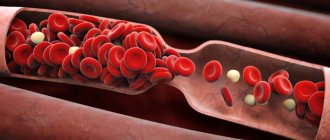In this article we will tell you about a very important topic - hematomas in early pregnancy. They appear, as you know, quite often and bring a lot of anxiety. We will talk with an obstetrician-gynecologist, a reproductive specialist at GMS IVF.
After the long-awaited pregnancy, we want to believe that now all the problems are behind us, and our baby is already with us! But a very difficult period of pregnancy begins, which is also full of pitfalls and stress that a woman has to face. One of the worst situations for a pregnant woman is the appearance of bloody discharge from the genital tract. In this case, abandoning all her affairs, the woman rushes to the doctor in horror to make sure that the baby is alive and in the uterine cavity. And after an ultrasound examination he often hears the verdict “Retrochorial hematoma.” What kind of pathology is this, why does it appear, how dangerous is it - this is what my story is about today.
A retrochorial hematoma is a collection of blood in the space between the wall of the uterus and the membrane of the fertilized egg (the chorion, which becomes the placenta after 16 weeks of pregnancy).
Most often this occurs due to the threat of termination of pregnancy, when, for example, in response to an increase in the tone of the uterus, the fertilized egg partially exfoliates from its wall, slight bleeding begins, but the blood stops and remains in the cavity of the exfoliated area. Also, a hematoma can occur due to the germination of the walls of the uterine vessels by the villi of chorionic tissue.
What are the consequences of the state of hemoconcentration?
Why is hemoconcentration (blood thickening) dangerous during pregnancy? Both the mother and her unborn baby can suffer from this pathology. The doctor immediately puts this situation under control, since the following consequences may occur:
- Varicose veins,
- The appearance of blood clots
- Stroke,
- Heart attack.
For a child, this situation is even more dangerous. He faces:
- Oxygen starvation,
- Pathological development,
- Fading pregnancy
- Risk of miscarriage,
- Premature birth.
Risks for mother and baby
The main danger lies in the formation of blood clots.
Often, after childbirth, a new mother may develop varicose veins. Blockage of blood vessels can negatively affect both the fetus, which will experience oxygen deficiency, and the expectant mother herself. Because of this, the possibility of miscarriage or premature birth, heart attack or stroke may increase significantly. In the early stages, excessively thick blood can lead to a frozen pregnancy. Therefore, it is so important to visit a doctor on time and fully follow his recommendations. If you have any doubts about the prescribed treatment, immediately consult with several doctors, so you can eliminate the risk of medical error or negligence.
Complications and prognosis
With timely diagnosis and high-quality treatment, retrochorial hematoma in most cases does not pose a further threat to the course of pregnancy, which ends safely through the natural birth canal, especially if the hematoma occurs in the early stages of pregnancy. But unfortunately, partial chorion detachment can also cause the formation of early placental insufficiency, premature aging of the placenta and fetal malnutrition. The risk increases with bleeding occurring at 7–12 weeks of pregnancy; in this situation, pregnancy may cease to develop in 5–10% of cases. Retroplacental hematoma that occurs in later stages of pregnancy, especially located below the umbilical cord insertion site, is accompanied by the risk of spontaneous miscarriages, premature abruption of a normally located placenta, premature birth, retarded fetal growth and development, and the development of feto-placental insufficiency.
Another important prognostic sign is the size of the hematoma - the prognosis is considered unfavorable if the volume of the hematoma is more than 60 cm³ or if the area of the hematoma is 40% or more of the size of the fetal egg.
Conclusions:
- Retrochorial hematoma may be an asymptomatic, incidental finding on ultrasound.
- Spotting bloody discharge from the genital tract in the presence of a retrochorial hematoma is a favorable symptom of its emptying.
- Even in the absence of bloody discharge from the genital tract, in the presence of a retrochorial hematoma, complete physical rest and adequate complex therapy are necessary (the most effective is in a hospital setting).
- A hematoma that occurs in the early stages of pregnancy, with timely treatment in most cases goes away without consequences.
- The prognosis for the further course of pregnancy after the formation of a retrochorial hematoma depends on the period of pregnancy at which it appeared, its location, and its size.
And most importantly, in the presence of such a complication, do not panic, but strictly follow all the recommendations of the attending physician. Then you will have every chance to safely and happily carry and give birth to a healthy baby on your own!
Is thick blood during pregnancy dangerous for the woman and fetus?
Having identified a change in blood density in a pregnant woman, the doctor assesses the degree of these disorders and determines the tactics for managing the patient.
It is based on the results of a coagulogram that a specialist will be able to determine the degree of danger of blood thickening during pregnancy. In some cases, with minor changes in indicators, the doctor does not attach serious importance to blood density and gives the woman general recommendations regarding diet and fluid intake aimed at eliminating this symptom. In such situations, you should not worry, because such blood thickening does not pose a threat to either the expectant mother or the fetus, and after childbirth, the coagulogram indicators stabilize on their own.
Sometimes the cause of blood thickening during pregnancy is taking iron-containing drugs, which are prescribed when hemoglobin levels decrease. Such a symptom should also not cause concern in a woman, because after eliminating anemia and discontinuing these medications, the blood condition will stabilize.
For more serious changes in coagulogram parameters, the doctor may recommend that the pregnant woman undergo a course of blood thinning therapy. In such situations, a woman should also not worry, but simply follow all the doctor’s orders. The danger of such blood thickening lies in the increased risk of blood clots and obstructed blood flow through the vessels, but this situation can be corrected.
The slow flow of viscous blood through the vessels and a more intense load on the heart causes insufficient supply of oxygen and nutrients to all tissues and organs. This leads to the following symptoms in a pregnant woman:
- constant lethargy;
- memory impairment;
- drowsiness;
- dry mouth;
- heaviness in the legs;
- coldness of the extremities.
With a sedentary lifestyle and lack of treatment, an increased tendency to blood clots can lead to the development of the following complications in the expectant mother:
- thrombosis;
- thrombophlebitis;
- TELA;
- varicose veins;
- diseases of the cardiovascular system (heart attack, hypertension, stroke, atherosclerosis).
Significantly increased blood density also negatively affects the condition of the unborn baby. As a result of increased thrombus formation and slow blood flow, the following disorders may occur on the part of the fetus:
- miscarriage or premature birth;
- frozen pregnancy;
- hypoxia;
- developmental delay.
It is in connection with the above possible complications of thick blood that women planning a pregnancy should refuse to conceive until the course of treatment for this condition is completed. In some cases, this disorder in the blood coagulation system can be life-threatening for the expectant mother and baby, and not all medications can be taken by a woman while carrying a child. Therefore, it is better to get rid of this symptom before pregnancy.
- Thick blood what to do: how to thin thick blood
When planning a conception, the doctor will definitely prescribe a coagulogram to rule out disorders in the blood coagulation system. It is especially important to conduct such a study in certain risk groups:
- the woman has a history of miscarriages or missed pregnancies;
- the woman or her relatives have varicose veins;
- close relatives of the woman had thrombosis, heart attacks or strokes;
- a woman professionally engages in sports that involve intense physical activity.
What blood tests can indicate blood clotting?
If you suspect an increase in blood viscosity, your doctor will prescribe a blood clotting test.
Thick blood can be caused by a variety of factors and diseases. In some cases, a woman may not even be aware of them.
In most cases, a pregnant woman finds out that she has thick blood at her next doctor’s appointment after she has passed a general test. The doctor will definitely notice an increase in the level of blood cells and hematocrit and will inform the woman about this. Sometimes a pregnant woman can learn about thick blood from a laboratory technician who takes blood from a vein and notices that it is poorly absorbed into the syringe, clogging the lumen of the needle. You should definitely report this phenomenon to your doctor.
If the above-described signs of blood density are detected, the doctor will definitely refer the pregnant woman for a test such as a coagulogram. It is this research method that will help to study the state of the blood coagulation system in more detail and will predetermine further tactics of diagnosis and therapy.
Coagulogram indicators determine the following blood parameters:
- fibrinogen – the norm is 2-4 g/l, with increasing gestational age the figure increases to 6 g/l;
- thrombin time – normal 11-18 s;
- APTT is normal 24-35 s, with an increase in fibrinogen due to an increase in pregnancy, this indicator accelerates to 17-20 s;
- prothrombin – normal 78-142%;
- lupus anticoagulant – normally absent.
With increased blood density, coagulogram parameters change as follows:
- fibrinogen – increases;
- thrombin time – accelerates;
- APTT – accelerates;
- prothrombin – increases;
- lupus anticoagulant – present.
Remember that only a specialist can decipher the results of a coagulogram and assess the degree of blood density! It is he who will be able to decide on the advisability of prescribing drug treatment.
Causes
While carrying a baby, the expectant mother is faced with a huge number of tests. A general blood test and hemocoagulogram are mandatory tests that are included in the recommended list of laboratory tests performed during pregnancy.
“Thick” blood is a clinical concept that is defined when the amount of formed elements in the blood is significantly increased. Typically, various thrombus formation disorders lead to the development of this situation during pregnancy. These pathologies can appear both in the early and late stages of pregnancy.
It should be noted that normal blood is quite liquid. This physiological feature is necessary for its transport and nutritional functions to be fully realized.
There are quite a lot of different nutrients dissolved in the blood, as well as oxygen. All these elements are needed by the fetus for its active growth and development.
The development of pathological disorders associated with the formation of thick blood is caused by the following causes:
- Individual characteristics of the expectant mother. If a woman had any hematological disorders before pregnancy, then during pregnancy they will progress significantly. This situation usually occurs in families where several members have various diseases of the cardiovascular system. A history of heart attack or stroke in close relatives of a pregnant woman is also a predisposing factor to increased thrombus formation.
- Violation of the drinking regime. Insufficient intake of water into the expectant mother's body can lead to her blood becoming thicker. This violation occurs quite often if a woman suffers from toxicosis. Frequent vomiting contributes to dehydration, which leads to severe blood thickening.
- Insufficient supply of essential vitamins and microelements. Vitamin balance is very important during all periods of pregnancy. Carrying a baby is a very energy-intensive time. To carry out all biological reactions, enzymes are needed, which cannot be formed in the mother's body without certain vitamins and microelements.
- Frequent consumption of sweets and other “fast” carbohydrates . A large amount of sugar entering the blood leads to a significant change in its viscosity. If the expectant mother eats a lot of sweets and candies throughout her pregnancy, this can not only contribute to increased blood clot formation, but even lead to the development of signs of diabetes mellitus.
- Oversaturation of the body with iron-containing drugs . These drugs are usually prescribed to pregnant women who have had a decrease in hemoglobin during pregnancy. Excessive intake of iron-containing drugs can lead to an increase in platelets in peripheral blood.
- Impaired functioning of the spleen . This organ is necessary for the body to maintain optimal concentrations of blood cells. Hypersplenism is a pathological condition that is characterized by significant disturbances in the functioning of the spleen.
This pathology, which occurs during pregnancy, also contributes to the progression of thrombosis.
It is important to note that there are a number of specific pathologies that occur mainly only during pregnancy. antiphospholipid syndrome can lead to an increase in blood viscosity and disruption of its fluidity Doctors note that the incidence of this pathology is only growing every year.
Severe blood loss or traumatic shock resulting from some type of injury may also cause baseline blood counts to change. These pathologies can also appear if a pregnant woman shows signs of internal bleeding. This condition is already extremely unfavorable and requires urgent medical attention.
- Finger joints hurt during pregnancy: causes of pain in the hands
Calculate gestational age
Diagnostic tests to determine blood viscosity
Often, too thick blood during pregnancy is detected during routine testing. When blood is taken from a finger, it clots too quickly, clogs the tubes, flows poorly, etc.
However, visual analysis alone is not enough to correctly diagnose and identify the causes of pathology. A coagulogram is intended for these purposes. This diagnostic method helps determine whether there are problems with blood clotting and helps develop the correct treatment tactics. The examination is carried out only on an empty stomach.
The following indicators are important for making a diagnosis:
- Prothrombin index. It shows the rate of blood clotting as a percentage. The optimal indicators are 110% with deviations of 32%. If the patient's readings are higher, the blood is too thick.
- Fibrinogen content. In the first trimester, its amount should be from 2 to 4 g/l, in the third – about 6.
- Thrombin time is the rate at which a blood clot forms. Normally, it is formed in 15 s. For pregnant women, the indicator is slightly increased - up to 25 s.
- Lupus coagulant - a woman's tendency to develop lupus.
- Activated partial thromboplastin time. Normally it ranges from 25 to 35 s, for pregnant women - from 17 to 20 s.
Treatment for retrochorial hematoma
It is recommended to treat retrochorial hematoma, mainly because only there it is possible to ensure truly complete physical rest and the absence of any stress. No promises to “lie down all the time” at home can be realized - there will always be a bunch of urgent household chores that you want to do - from cleaning to laundry. In addition, the hospital can provide emergency assistance at any time - intravenous administration of hemostatic agents, for example. If it is not possible to go to a hospital, then you should consider the option of a day visit to the clinic or staying with us for a couple of days.
Bed rest is recommended, and in order to restore the outflow of blood, it is advised to lie down with a cushion, for example made from a rolled blanket, under the pelvic area. To prevent congestion in the intestines, it is recommended to follow a diet: exclude legumes, spicy foods; products that strengthen stool or enhance intestinal motility (chocolate, coarse fiber). The intestines overflowing with gases put pressure on the pregnant uterus and increase the tone of the uterus, which increases the threat of miscarriage and increases the size of the hematoma. Also, to reduce the risk of increased uterine tone, you need to limit the consumption of strong tea and coffee.
Drug therapy consists of using drugs that improve blood clotting, due to which bleeding stops and the hematoma stops growing (tranexam, dicynon, vikasol). To relieve hypertonicity of the uterus, due to which the hematoma can grow, antispasmodics (no-spa, metacin, suppositories with papaverine) are used. In order to normalize hormonal regulation in the body, metabolic vitamin therapy is used. Progesterone preparations are used. In this case, the scheme and route of administration are selected individually by the doctor; these can be either drugs for intramuscular administration (oil solution of progesterone), or suppositories (Utrozhestan, Iprozhin), tablets (Duphaston) or gel (Crinone). It should be noted that when bloody discharge appears from the genital tract, utrozhestan continues to be administered intravaginally. Its effectiveness is not reduced!
Treatment usually lasts from 2 to 4 weeks, and, if indicated, is repeated at critical times (12–14, 20–24, 28–32, 36–38 weeks). Resorption of the hematoma usually occurs from 2 to 4-5 weeks.











